
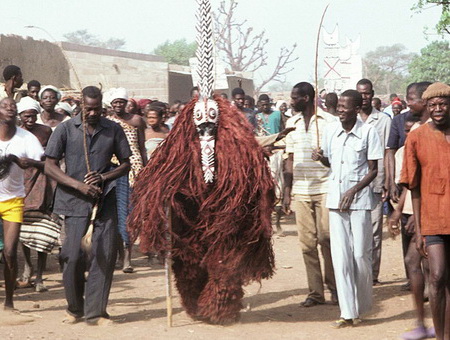
The Bwa is an African society that is native to Burkina Faso. This society has an approximate population of over 300,000 persons. The Bwa people live in a number of individualized communities. They have no central government, and rely on their community standards. They are most known for their scarification and elaborate plank masks.
The history of the Bwa is characterized by a succession of outsiders attempting to take advantage of their independently organized villages. In the 18th century, the Bamana empire of Segou came into power and occupied a large portion of the Bwa lands in Mali. They forced the Bwa to pay taxes and carried out raids in the unconquered areas. In the 19th century, the Bamana empire declined, only to be replaced by the Moslem Fulani empire in the north. They also carried out incursions into Bwa territory, destroying crops and villages, stealing animals, enslaving men and women, and conscripting men into their armies. In 1897, the French arrived on the scene, only to use the Fulani as mercenaries in order to control the region. In 1915, the Bwa revolted against the French demand for military recruits. The French responded by destroying all the offending villages.
The Bwa live in central Burkina Faso and south-east Mali, between Mali's Bani River and the Mouhoun River (Black Volta) in Burkina Faso. Their total population is approximately 300,000. The major towns occupied by the Bwa are Houndé, Boni, Bagassi, Dossi and Pa.
Early European explorers to the area called the Bwa "Bobo", confusing them with their neighbours the Bobo people. Although the two groups share religion and culture, they are ethnically distinct. The confusion led to alternative names for the Bwa including Bobo Oule, or Eastern Bobo. In Jula, Bobo Oule means "Red Bobo". This distinguishes the Bwa from the Bobo who are called the "Black Bobo".
The White Bobo, Bobo Gbe, are also Bwa.
The southern Bwa became known by their neighbours as Nieniegue meaning "scarred Bwa" as a result of the tradition of scarification of their faces and bodies. This practice is no longer commonplace and so the term is also in decline.
There are three professional castes within the Bwa society: the farmers, the musicians, and the blacksmiths.
Farming has been a constant way of life for the Bwa. It is their primary source of income with their most successful crop being cotton. Besides cotton, though, the Bwa are known to harvest certain grains such as millet, rice, sorghum, yams, and peanuts. These crops along with other grains and various fruits are used for both nutritional and medicinal purposes.
Music is integral to the Bwa's traditional ceremonies and rituals. While they do use drums, the Bwa are known to craft and play flutes carved from wood.
Blacksmiths in the Bwa society work mostly with bronze to craft masks, figures, utensils, and jewelry. These works can be bought and sold, used for personal use, and/or are utilized during rituals.
Bwa villages are autonomous and they do not recognise any outside political authority. They are led by a council of male elders who make all the major decisions.
The Bwa speak Bwa languages, a closely related group of Gur languages of the Niger–Congo family. Some speak Jula (Dioula) for trading and communication with outsiders, and French is also used.
The creator deity of the Bwa is known as Wuro, a god who designed the earth with the intention of establishing balance. Wuro was said to be hurt by a human, and in return, he decided to send his eldest son Dwo to act as the communication line between him and the people. Wuro had three sons: Dwo, the god of rebirth, Soxo, the god of the wilderness, and Kwere, the lightning god. Two and his significance is heavily depicted in the Boni Bwa's ceremonial leaf masks. Animism is the main religious belief practiced by the Bwa. In fact, the art work that the Bwa are known for is primarily used for animist practices—specifically that of Nuna origin.
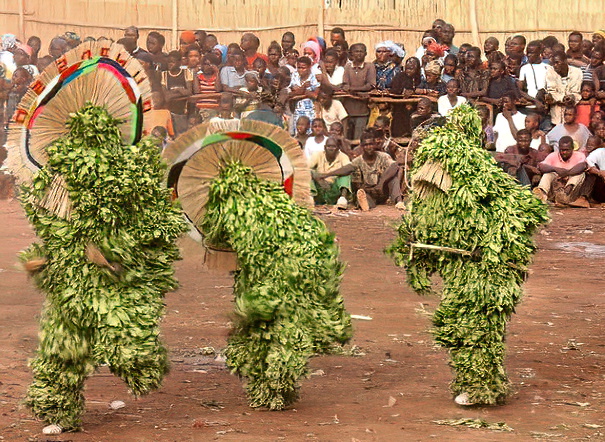
Nuna practices still hold firm in the Bwa culture. In relation, there is a group called the Cult of Do (or Dwo). They are led by the village's eldest male member, the Labie (also known as the earth priest.)
With that being said, they have also adopted both Islam and Christianity as a result of their prior invasions.
While the Bwa are famous for their masks, it is the purpose behind the pieces that provides the real significance. Using these masks, along with scepters and diverse body adornments, the Bwa will dance and perform these items in representation of different spirits. Those Bwa members who have gone through initiation—a process of transitioning from a child to an adult member of society—are grouped together in age grades. During ceremonies, they adorn and praise the masks that are being performed as a group. It is also important to note that these mask performances are not gender specific. Women are very much a part of these events just as much as their male counterparts.
The Bwa use various divination sculptures and carvings to carry out significant ceremonies and practices. While sculpted figures are a rare art of the Bwa's, the pieces would be used for events such as divination ceremonies, fertility rituals, and offered sacrifices.
The Bwa live in autonomous villages which do not recognize an individual political authority. All decisions are made by a council of male elders of the local lineages. External infringements on this system have been historically resisted. While the independence of Bwa villages has proven an advantage in the face of local crises, when the people have quickly organized and taken action almost immediately, it has also prevented the Bwa from forming strong alliances when confronted by outside invaders.
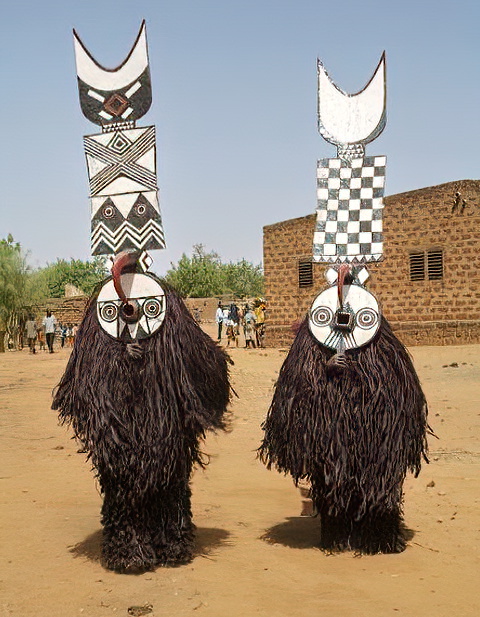
The Bwa masks are usually black and white; additional colors are subject to individual carvers and their styles. Animal depictions are a common attribute of the works. Plank Masks are the most known style of masks for this society. they are vertically shaped and attached to a disk-like base. Decoration is subject to change, but it mostly comes down to zigzags, squares, and circles. The Bwa also make horizontal and heterogenous masks. Heterogenous masks have an ovoid head with round and/or diamond eyes. Sometimes, the artist will choose to add on designs such as crescents or human figures.
The Bwa are well known for their use of traditional tribal masks. There are several types of masks produced by the Bwa that are used in traditional rituals.
In particular the Southern Bwa are known for their tall plank masks, known as nwantantay, and tend to use wood to make their masks. This is a result of their adoption of Nuna religion and their traditions of using wooden masks. The religion associated with wooden masks is focused on the spirit Lanle, whose power is manifested through the wooden masks. Nwantantay can also be made of polychrome by the blacksmiths. Built in horizontal shapes, these masks can represent different animals and have specific designs. For example, a butterfly mask would have concentric circles, while a hawk mask would have a plain white surface. these masks are worn for female entertainment.
The northern Bwa use leaf masks more than wooden ones. These leaf masks frequently represent Dwo in religious ceremonies. The masks also represent the bush spirits including serpents, monkeys, buffalo and hawks. Mask performances generally take place in the dry season between February and May.


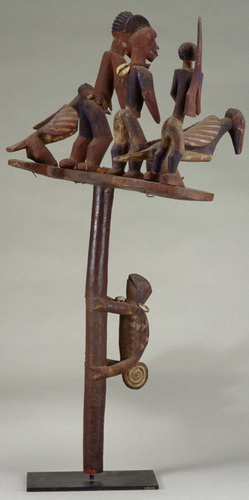
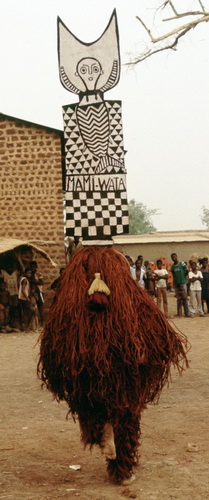
Blacksmiths are also known to make utensils and body adornments for their people. These pieces, much like the masks, tend to represent animals and their attributes associated with them. For example, a blacksmith may use a hyena to show stupidity or a bush cow to symbolize strength. The most common depictions are of the double chameleon and the hornbill. The chameleon would be mostly used by women who want to have children but cannot.
Flutes are used daily. They are usually played in sets of 5 to 9 pieces. By playing short diverse patterns in an interlocking form, the musicians tell a story. It is a form of communication—reproducing the speech of tonal languages. They are commonly accompanied by dances.
Sources: